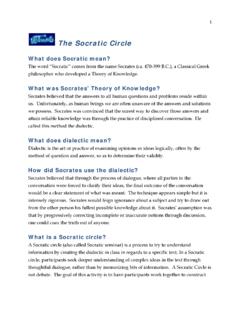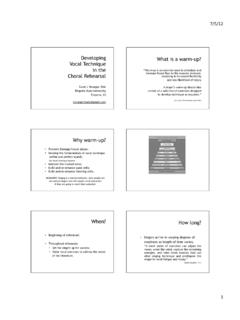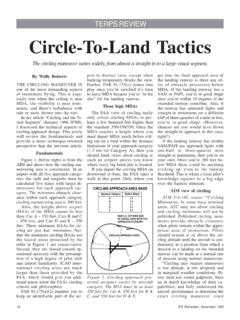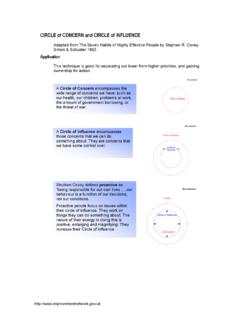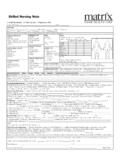Transcription of Dance Terminology
1 Arabesque One ofthe basic poses ofballet. A position ofthe body,supported on one le g, which can be straight or demi-pli , with the otherleg extended behind. The forms ofarabesque are varied to A pose in Dance derived by Carlo Blasis from the statue ofMercury by Giovanni da Bologna. A position on one leg with the otherlifted in back (or in front or side), the knee bent at a 90 degree angleand well tuned out so that the knee is higher than or level with the A jumping movement pushing from and landing on the same free (working) leg performs a rond de jambe while the supporting legpulls up to a tuck as the dancer makes a full rotation in the change A transitional weight change that pushes to ball oftheworking foot and returns to the supporting leg. Can also be performedin a stepping-through saut Brushing and stretching the working leg (as in grandbattement) while pushing to a saut with the supporting leg.
2 Done as apreparatory exercise for several other leaps and A step in which the extended legs are beaten in the air. Theworking leg is pushed into the air and the supporting leg follows. Thelanding is then made on the same supporting s Literall y, chains or links. Series ofturns performed in releveusually moving across the floor. The term is actually an abbreviation for tours chain s deboules .Chass Meaning chased . A step in which one foot literally chasesthe other out ofits position. Can be done in a series or used singly as atransition step. Chass should glide along the floor making sure that thefeet kiss in the turn- A half turn ex ecuted by crossing the working foot behind thesupporting leg and simply untwisting the legs leaving the body facing theopposite Disengaged. The pointing ofthe foot by brushing along thefloor until the foot leaves the ground and extends fully.
3 May also bereferred to as battement glisse, gliding off the A position where the working foot is placed directly beside thesupporting foot at the turn- A pirouette movement performed with an inside in pli /releve on the supporting leg while the working leg trailswhile physically dragging the floor either to the side, behind or diagonal-ly back. A very stylized a terre The term fouett means literally whipped . In thiscase the supporting leg is placed in tendu to the front or back while thesupporting leg raises the heel as the body rotates over that leg by turn-ing through the hip socket. The body ends up facing the opposite direc-tion while the foot/leg in tendu has remained in the same rond de jambe en tournant The fouett most commonlyref erred to as just fouett . Literally , whipped circle ofthe leg popular turn in which the dancer executes a series ofturns on the sup-porting leg while being propelled by a whipping movement ofthe work-ing leg.
4 The working leg should pass through the fourth position beforebeing raised to hip level in the second position and then into the pass position to complete the turn. The closure at pass may be beaten or leftto a simple , a la seconde Like the other popular fouett , this turn is usu-ally executed in a series. The leg in supported in second position at hiplevel for the completion ofthe turn instead ofbeing pulled in to pass .Fouett , saut The same basic motion as the fouett a terre, but exe-cuted out ofa chass (or another traveling step). The working leg beginswith a grand battement as the working leg pushes offthe floor to fullyextend under the body. The whipping motion rotates leaving the work-ing leg in the air and then landing again on the same supporting leg asleaving the battement The working foot brushes the floor pointing at sepa-ration and continuing in altitude with a straightened and tightened kneeand foot.
5 The body should remain calm with the leg being thrown onlyto the maximum height allowed without disturbing the body leg is closed back into the position in which it jet In this step the legs are thrown to a split in the air. Thefront leg should leave the floor as in grand jet .Grapevine - A series ofsteps moving side to side. Executed by steppingto the side (2nd), crossing back (or front) and then continuing in the samedirection stepping out to the side again. Can be finished with a varietyofsteps including a dig or a touch out to the side that would then takeyou into a reverse performance ofthe - Throwing step. A jump from one foot to the other in which theworking leg is brushed into the air and appears to have been de bourr e Though there are many variations, the most common-ly used versions are a combination ofsteps which move the feet in thepattern of back, side, front.
6 In the jazz variation, the pattern isamended to move cross back, open second, lunge out . The patterncan be performed in either direction and is usually applied as a transi-tional de Chat literall y, step ofthe cat. A ballet jump in which the feetare lifted, one after the other, to the level ofthe opposite knee in aturned out de Chat, Russian A leap which moves with the leading leg extend-ed to second position at hip level and the supporting leg pulled under-neath in a turned out position. Landed on the leading leg. Marching Auxiliaries 2007 Dance TerminologyPass Passed. Literally , the step would have the foot leave fifth posi-tion in front (although other positions may be used) and pass the kneejoint to finish in the fifth position in back. Also performed in term is most commonly referred to as the position where the toesconnect to the leg just below the knee to perform Leaning or inclining as in pench arabesque.
7 Keeping the bodyin the same angular proportions while tipping either forward or turn A turn performed in either direction on one toe while keep-ing the other leg very closely parall eled. Piqu Pricked or pricking. Stepping directly onto the pointed leg (atthe demi-point) while lifting the other leg to a variety ofpositions. Canbe used with arabesque, pass , turn A piqu performed in the pass position while turning tothe inside. Usually done in a Whirl or spin. A complete turn ofthe body performed onone foot. May be performed in many positions ofthe working leg toinclude pass , arabesque, attitude, a la seconde (second position sup-ported waist level) and fourth A step that changes the direction ofmotion. Place right footforward and transfer weight. Flip the shoulders to face back by turningover the left shoulder.
8 Can be Bent or bending. A bending ofthe knee or de bras Carriage ofthe arms. In general, the use or movement ofthe arms through either specified classical positions or as they are placedin de jambe a terre Round ofthe leg on the ground. The circularmovement ofthe leg, originating in the hip. Both legs must be keptstraight while the toe ofthe working leg traces a circular pattern on thefloor. Can be performed with the movement beginning as a tendu infront or directly behind the de jambe, grande The same movement described a terre butexecuted at 90 A popular leap that travels through the air in the same man-ner as grand jet and saut de chat, but with the body open to the audi-ence and the legs extended in second position on both , switch Executed in the same manner as the basic switch leap,but with the body opening into the open second position in the de basque A traveling step in which the dancer turns in the airwith one foot drawn up to pass or coup.
9 Completed by gliding out toperform the step in a series or to transition. A chass tour (turning) isan appropriate beginning movement to acquaint the dancer with thebasic movement. The turn is then ex ecuted in fifth position with a chas-s into and out ofthe Jumped or jumping. When this term is added to the name ofastep, the movement is performed while A turn performed by stepping onto a straightened leading leg,crossing the trailing leg in front at the knee and then rel easing the lead-ing leg as the turn untwists. The leading leg is then free to reach againfrom fourth position to repeat the turn in a series. Can also be usedsingly as an accent or eagle jump Also referred to as a star jump, X jump and sever-al other terms by region. Begins in parallel first position, jumps to legsin a wide second in the air with arms in a high V.
10 Returns to the paral-lel first to leap Begins as a grand jet . Throws the leading leg to the backwhile the supporting leg throws to the front to complete a full split in theair. The switch leap should complete a split on both legs before Stretched. Movement is initiated in the heel by pushing forwarduntil the foot is forced into the fully stretched and pointed position. Canbe performed front, side and step turn Performed by stepping to second position right, turn-ing over the right shoulder to step left, and then turning again over theright shoulder to return to the right foot. Can be reversed. The move-ment should turn the dancer in the same direction for all three touch A very popular jump that may also be called a straddlejump. The jump begins in a parallel first position, springs to a very widesecond position in the air with the arms traditionally extended over thetoes.




